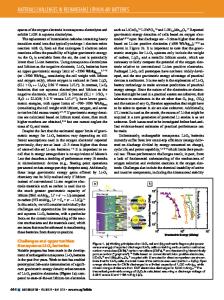Asynchronous stoichiometric response in lithium iron phosphate batteries
- PDF / 766,962 Bytes
- 7 Pages / 584.957 x 782.986 pts Page_size
- 57 Downloads / 680 Views
Zhong Zhong Photon Sciences, Brookhaven National Laboratory, Upton, New York 11973, USA (Received 15 June 2014; accepted 8 October 2014)
Operando energy-dispersive x-ray diffraction (EDXRD) was carried out on a newly formed 8 Ah lithium iron phosphate (LiFePO4) battery with the goal of elucidating the origin of asynchronous phase transformation commonly seen with in situ x-ray diffraction studies. The high-energy photons at the NSLS X17B1 beamline allow for penetration into a fully assembled battery and therefore negate any need for a specially designed in situ cell which often uses modified current collectors to minimize x-ray attenuation. Spatially-and-temporally resolved phase-mapping was conducted with a semiquantitative reference intensity ratio (RIR) analysis to estimate the relative abundance of the delithiated phase. The data show an asynchronous response in the stoichiometry versus the electrochemical profile and suggest limited diffusion in the electrode toward the end of discharge. Our results confirm that the asynchronous electrode response is not just limited to specially designed cells but occurs in fully assembled cells alike. We attribute this behavior to be a consequence of performing a local measurement over a wide-area heterogeneous reaction.
I. INTRODUCTION
The use of lithium-ion batteries in portable electronics has enabled a proliferation of devices in recent years. Still, the present-and-future requirements of energy storage for transportation and grid applications are not yet met by available technologies. Specifically, energy density, power capability, cycle life, calendar life, and safety all need improvement. Low-cost manufacturing will also be required for lithium-ion batteries to compete with existing power infrastructure.1–3 One of the main hindrances in the progress of battery research is that the constituent electrode materials are inaccessible once an electrochemical cell is constructed. This leaves the researcher with a limited number of available feedback mechanisms to assess the cell’s performance, e.g., current, voltage, and impedance. Indeed, there is a whole scientific community dedicated to the study and modeling of such electrochemical data.4 However, these data are limited in their ability to reveal the more-localized smaller-scale structural mechanisms on which the batteries’ performance is so dependent.5 In the last 20 years great advancement has been made in the area of in situ characterization using x-rays, enabling
a)
Address all correspondence to this author. e-mail: [email protected] DOI: 10.1557/jmr.2014.321 J. Mater. Res., Vol. 30, No. 3, Feb 14, 2015
researchers to study battery materials without removing them from a cell. Aside from improvements in probe brightness and detector efficiency, these advancements can largely be credited to the construction of new cell designs utilizing low-absorption encapsulation and current-collector materials, thus allowing for greater penetration of x-rays. Such work has enabled discovery of hidden phases and the screening of
Data Loading...











